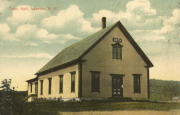Andover Town Hall from
History of Andover, New Hampshire 1900-1965
By Ralph H. Chaffee
published in 1966 by Equity Publishing Corp., Orford, N.H.
(A number of area residents have expressed curiosity about the history of the building at 157 Main Street, now called The Andover Hub. The following tells the story from its beginnings in 1879 until 1965. ( Look for an account of its later history in a future Beacon.)

For many years, and at many town meetings, the rival citizenry of Andover and East Andover tried unsuccessfully to agree upon some location upon which to build a “town house”. The battle raged back and forth until finally, in 1879, agreement was reached upon the one-half acre site in the central Andover village. Complete with stoves, fixtures, and the big iron safe since moved to the new town office, the original part of the town hall cost $1,987.20. The only stage was a platform in the middle of the west side of the hall. For building the structure itself, Hamilton & Woodbury were paid $1,223.15, the Hamilton being the same Albert R. who also built three of the town’s seven covered bridges.
An extension was added in 1904, providing the present stage area and a kitchen in the basement Running water was piped in six years later in 1911 after the Andover Village District was formed. Electric lights came in 1922 when the lines of the East Andover Light & Power Co. reached the village.
Few other improvements were made until the Andover High School was built in 1934. This had no facilities for basketball and the town hall became the school gymnasium. The cracking plastered walls were covered with plywood to better withstand the bouncing balls. In one last final improvement, a steam heating plant was installed beneath the stage in 1948, with toilets, showers and dressing rooms. The original tall double doors at the front entrance were replaced by two shorter ones of rosewood salvaged from the Hotel Touraine in Boston.
For another fifteen years, the old town hall continued to be the center of town and school sports activity. Little was ever done to beautify the front yard, as the lot had become completely surrounded by garages and an automobile graveyard. All available space was needed for parking.
After the new school gymnasium was completed in 1963. the town meeting felt that it would be uneconomical to continue the upkeep of a town hall, as the new school facilities would serve all needs equally well or better. True, there was a desire on the part of many older residents to preserve the building for sentimental reasons, but sentiment was overridden by economy and a vote to sell prevailed. As there seemed to be little demand for this type of building at private sale. the selectmen advertised that it would be sold at public auction on Aug. 17, 1963. There are no other known instances of a town hall being sold at public auction. Andover’s road agent, john Jurta, Jr., became the new owner for $4,800, less than the $6,000 expended for the new heating system.
During the eighty-four years of its public ownership, the “town house” was the center for many kinds of activity. Town meetings and elections, dramatic plays, minstrel shows, school plays and graduation exercises, dances, lectures and moving pictures, medicine shows, public entertainments of many kinds, and innumerable meetings of various groups and organizations for many purposes — for all of these and many more the old town hall was the natural meeting place….